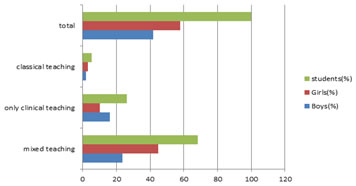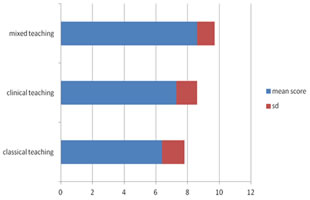|
Table of Content Volume 17 Issue 3 - March 2021
Study to evaluate the effectiveness of clinical oriented anatomy teaching to medical students
Utkarsh G Shrivastava1*, Vijay Nayak2, Kailash Balkund3
1Assistant Professor, Department of Anatomy, VIMS, Dahanu, INDIA. 2Associate Professor, Department of Anatomy, GMC Khandwa, INDIA. 3Associate Professor, Department Of Anatomy, AIIMS Raebareli, INDIA. Email: utk2710@gmail.com
Abstract Background: Anatomical knowledge of students is influenced by various effective methods of teaching It has been proved that basic science knowledge learned in the context of a clinical case is actually better comprehended and more easily applied by medical students than basic science knowledge learned in isolation. The present study intended to evaluate the effectiveness of Clinically Oriented Teaching of anatomy in undergraduate medical curriculum. Methods: Clinical oriented anatomy teaching is a teaching strategy wherein, students were taught physiology using cases and critical thinking questions. In this study a questionnaire was prepared for the students of MBBS 1st proff. The response of the students was studied in depth and statistically analyzed. Different methods of teaching were evaluated through responses given by first MBBS students. Results: Comparison of different teaching methods shows that after mixed teaching (classical including clinical oriented teaching) scores of students were significantly higher compared to classical teaching method or only clinical oriented teaching method. Feedback from the students indicated that they preferred mixed teaching method which is found to e more effective in learning the subject. Conclusion: The study supports the fact that assessment and teaching patterns should fall in line with each other as proved by the better performance of the students in evaluation test by mixed clinical oriented teaching, and study denotes that motivation,understanding and application of subject is associated with the teaching method of the subject. Key words: clinical oriented teaching, classical teaching method, mixed teaching, evaluation test
INTRODUCTION Medical students are classically taught anatomy at the start of their medical education during this phase of training, most of the teaching hours are delivered on site at a higher education institution rather than a clinical setting. Classically students being taught by delivering lectures and practicals with knowledge mainly based on anatomical details only, with very less clinical details.So it has been reviewed by many medical teachers to reach on a teaching method which would be more comprehensive, effective and helpful in learning ,remembering and applying anatomy knowledge in clinical practice of budding doctors. Anatomy is a subject core to all medical curricula, as a sound knowledge of anatomy underpins future clinical practice1,2. The paramount importance of maintaining an understanding of anatomical knowledge throughout clinical training is clear and without this, there is a risk of error in clinical practice due to anatomical miscomprehension, and ultimately potential for harm to patients3. Medical education has undergone tremendous changes over the years, education researchers have are continuously trying to review learning styles and new instructional methods. The present study attempted to validate the effectiveness of clinically oriented anatomy teaching in undergraduate medical students.
MATERIAL AND METHODS This cross sectional study carried out in the department of anatomy Chirayu medical college, Bhopal. A total of 288 first year MBBS Students form 2 consecutive batches participated in the study. All the students were taught topics of Anatomy through different methods of teaching (classical method, clinical oriented, mixed ) i.e. each student had the exposure of all the teaching modalities. At the end of teaching session, a predesigned and pretested questionnaire was given to students for the feedback regarding generation of interest and how much they understood the topic being taught. To assess the level of understanding of the topic by the mode of teaching modality, a 10 MCQ question test was used. The response of the students was studied in depth and statistically analyzed. The responses were entered in to Microsoft-office exel-2007. The categorical data was summarized as percentage and proportion and the continuous data as mean and standard deviation. Relevant graphical presentation was done.
OBSERVATION AND RESULTS The study was conducted on 288 students of first MBBS for 2 consecutive years, total 121 boys (42.01%) ,girls167 (57.98%) participated in this study. The students were taught topics of Anatomy through different methods of teaching (classical method, clinical oriented, mixed ) i.e. each student had the exposure of all the teaching modalities and their response was analyzed, results of this study after analysis show that maximum 197 (68.4%) of students preferred the combined method of teaching, while 76 (26.38%) were in favour of only clinical anatomy teaching, the least preferred method was classical anatomy teaching without clinical inclination, only 15 students (5.2%) preferred this method.
Table 1: Preference of different methods of teaching by students
Figure 1: Preference of teaching methods by students x axis showing Preference(in %) of teaching methods by students marks ,y axis denotes different teaching methods
Table 2: Performance of students in evaluation test after different methods of teaching by students
Figure 2: X axis showing marks obtained in evaluation test, Y axis denotes different teaching methods. Table 2 and chart 2 shows the mean scores of MCQ test (evaluation test) results which were taken after different methods of teaching, it shows that the performance of the students was best (8.6) by method of teaching which included classical and clinical orientation both included, This method followed by only clinical based teaching(7.3),whereas classical teaching without clinical orientation shows minimum scores (6.4).so it shows that mixed teaching method is better than other methods of teaching.
DISCUSSION Traditionally, anatomy was considered to be a dull, labour-intensive subject, and was taught using surface learning approaches and rote memorization6,7. However, the teaching of anatomy is undergoing an evolutionary change with the adoption of modern philosophies, approaches, and effective teaching and learning strategies. Among the teaching methods. Anatomy is the foundation stone over which the pillars of clinical sciences viz surgery, orthopedics, gynae etc are built. Medical students need to acquire core anatomical knowledge to build a strong foundation for future clinical encounters and professional practice2,5. JM Boon et al. (2001) have evaluated the effectiveness of clinical anatomy teachingat pretoria university in their study, most students thought that integrating the physical examination enhanced their understanding of the relevant anatomy (mean: 3.55). A substantial number of students thought the clinical anatomy in the block laid a good foundation for imaging anatomy of the abdomen (mean: 3.41). The majority of students thought the clinical anatomy laid a good basis for the understanding of surgical procedures relevant to the abdomen (mean: 3.63). Students were mostly confident that clinical anatomy enhanced their understanding of clinical presentations (mean: 3.68). singh et al. (2019) stated that 92% of students preffered new mixed approach of teaching.Reem Abraham et al.. derived that most of the students (91.14%) agree that clinical oriented teaching motivate them to learn the subject.while (94.45% ) felt it has improved the understanding of subject .mean percentage of scores of students in this study was improve in range of 33% to 38%.In present study the new method of combined teaching was found to be more effective than the traditional one. Statistically significant results were obtained on comparing the marks obtained by the students in the test post combined teaching method with the traditional method. We received overwhelming response and suggestions through student's feedback such as conducting more combined teaching sessions on difficult topics like embryology and more frequently throughout the year.
CONCLUSION There is considerable debate within the medical community about the best ways to teach anatomy. human body is the focus of investigation and intervention on a daily basis, Anatomy is obviously essential for surgeons but also has value for anyone who performs an invasive procedure on a patient; carries out emergency procedures; examines radio-logical physical examination of a patient; refers a patient to another doctor; or explains a procedure to a patient.Integration of newer teaching modalities and modern technology will encourage interest and retention of anatomical knowledge and its clinical relevance.In present study it was found that method of teaching which included classical and clinical orientation both was most effective method of teaching. In the present study, Clinical oriented teaching was found to be a useful adjunct to didactic lectures in teaching anatomy. The study supports the fact that assessment and teaching patterns should fall in line with each other as proved by the better performance of the students when trained to answer clinically oriented questions compared to the classical teaching methods. Mixed teaching with knowledge of Anatomy and its applied clinical importance was well received by the students. They were encouraged to realize the importance of anatomy in medicine and surgery and Clinical oriented teaching served as a stimulus for their critical-thinking insights. It is recommended that future research into anatomy education should focus on these factors which came in light through present study.
REFERENCES
Policy for Articles with Open Access: Authors who publish with MedPulse International Journal of Community Medicine (Print ISSN: 2579-0862) (Online ISSN: 2636-4743) agree to the following terms: Authors retain copyright and grant the journal right of first publication with the work simultaneously licensed under a Creative Commons Attribution License that allows others to share the work with an acknowledgement of the work's authorship and initial publication in this journal. Authors are permitted and encouraged to post links to their work online (e.g., in institutional repositories or on their website) prior to and during the submission process, as it can lead to productive exchanges, as well as earlier and greater citation of published work.
|
|
 Home
Home


